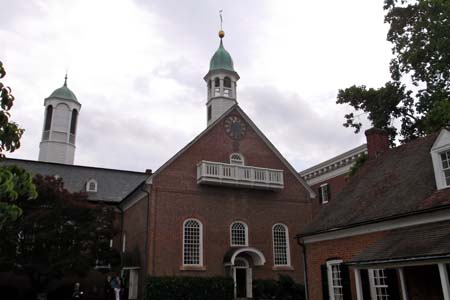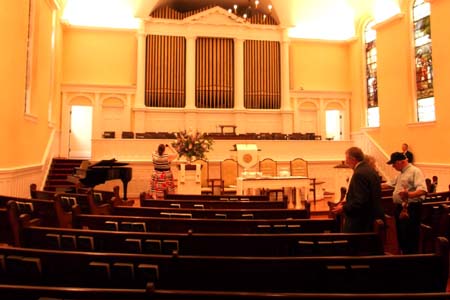| |
 |
 |
 |
| Comment on this report, or find other reports. |
 |
| Our Mystery Worshippers are volunteers who warm church pews for us around the world. If you'd like to become a Mystery Worshipper, start here. |
 |
| Find out how to reproduce this report in your church magazine or website. |
|
|
| 2703: Home Moravian, Winston-Salem, North Carolina, USA |
 |
 |
 |
Mystery Worshipper: Paterfamilias.
The church: Home Moravian, Winston-Salem, North Carolina, USA.
Denomination: Moravian Church in North America, Southern Province. The Moravian Church considers itself to be the oldest Protestant church, dating to the 15th century reformer Jan Hus. The Northern and Southern Provinces of the Moravian Church are in full communion with the Evangelical Lutheran Church in America and the Episcopal Church.
The building: Their current church was completed in 1800. The sanctuary underwent significant renovation in 1913. A Christian education and fellowship hall was added in the years before World War II. The space as a whole is simply appointed, with a few stained-glass windows at the sides, toward the front. At the front is a simple communion table, with four chairs behind for ministers leading the service; choir and organ are behind them. Congregational pews are arranged in a semi-circle, with an extensive balcony.
The church: Home Moravian is a large congregation, with all of the typical social groups, Christian formation activities (I was impressed that on Sunday mornings they have four different adult classes), and social justice ministries, as detailed on their website. The music program is excellent, and they sponsor a concert series (had I been in Winston-Salem just a bit longer, I could have attended a concert of "Three Moravian Tenors"). The women's fellowship organizes an annual candle tea, one of the opening events of the Winston-Salem Christmas season, with the singing of carols and demonstrations of beeswax candle making. Their Sunday service is at 10.00am each week; it is broadcast on a local radio station and live-streamed over the Internet via the congregation's website.
The neighborhood: The city of Winston-Salem, in the northwestern part of North Carolina, is a product of the merging of the two neighboring towns of Winston and Salem in 1913. The area was settled by Pennsylvania Moravians in 1753. Salem was established in 1766 as a permanent settlement, and Winston came much later, being founded in 1849. The tobacco and textile industries dominated the area's economy well into the 20th century, and still do. Today, Winston-Salem is headquarters for such firms as Reynolds American, Inc. (parent of RJ Reynolds Tobacco, maker of over a dozen brands of cigarettes, including Camel, Kool, Pall Mall, Lucky Strike, Winston and Salem); Krispy Kreme Doughnuts, Inc.; HanesBrands, Inc. (owner of the Hanes, Playtex, l'Eggs, Sheer Energy and other brands of, erm, unmentionables); Blue Rhino (the nation's largest supplier of bottled propane gas); and many others. The city has a population of nearly a quarter of a million residents. Home Moravian is located in the center of the Old Salem Museums and Gardens, where over a hundred buildings have been restored or reconstructed in a living-history recreation of early Moravian life in the area.
The cast: The Revd Richard L. Sides, pastor, presided at the celebration of holy communion. The Revd Virginia H. Tobiassen, associate pastor (she prefers to be called "Pastor Ginny"), gave the opening welcome and announcements. The Revd Dr Nola Reed Knouse, director of the Moravian Music Foundation, read the lesson from Acts and the gospel from John, and led the congregation in reading responsively the psalm that came between those readings. The Revd Margaret Leinbach, of the Women's Fund of Winston-Salem, gave the offertory invitation and prayer. Glenn Siebert, director of music, conducted a very capable choir of some twenty plus singers, and Susan Foster was organist. Prior to the service, the Home Church Band, an ensemble of about a dozen members led by Chris Jones, played chorales on the church lawn.
The date & time: Day of Pentecost, June 8, 2014, 10.00am.
What was the name of the service?
Holy Communion.
How full was the building?
Mostly full; I would guess 75 per cent or so; I did not get a good view of the balcony, but surely a couple of hundred were in attendance.
Did anyone welcome you personally?
I was handed a bulletin and welcomed when I entered.
Was your pew comfortable?
Quite. No kneelers.
How would you describe the pre-service
atmosphere?
Very chatty indeed; lots of conversations taking place. It quieted down fairly quickly when the four ministers entered and sat down.
What were the exact opening words of the
service?
Something like "It's so exciting to be a Christian on this day of Pentecost." I'm not quite sure, as I was seated near an entrance, and continuing conversation from outside covered up Pastor Ginny's first couple of sentences. This was followed by announcements, before the service proper began with the organ prelude.
What books did the congregation use during the
service?
Moravian Book of Worship, used by both the Northern and Southern Provinces of the Moravian Church, approved by the Southern Province in 1992. It is a combination service book and hymnal.
What musical instruments were played?
The Home Church Band is largely brass but with a couple of clarinets. During the service in church, there was only a pipe organ, a three-manual opus 1340 of the venerable Aeolian-Skinner Company, installed in 1959. One of the congregation's earliest organs, a single manual instrument dating from 1798 by the 18th century Pennsylvania organ builder David Tannenberg, has been relocated to the Single Brothers' House, built in 1769 as a residence for unmarried male choir members and now a museum, and is used to accompany carols at the annual candle tea.
Did anything distract you?
This was a service different in many ways from my usual fare, and so I couldn't afford to be distracted: I had to stay on task!

Was the worship stiff-upper-lip, happy clappy, or
what?
A formal liturgy, but with very little ceremonial. All four ministers were vested in simple white robes. After the organ prelude, the service began with a liturgy, which in Moravian parlance is a set of responsive readings, some seasonal, some topical, interspersed with hymns. We used the Liturgy for Pentecost and Spiritual Renewal, which included a confession of sin, declaration of pardon, and intercessions. We also used the Service for Holy Communion In Celebration of the Holy Spirit. This began with a greeting, followed by the congregation giving the right hand of fellowship (Galatians 2:9). We sang a hymn, "I come with joy to meet my Lord", to the tune Land of Rest. This was followed by a prayer of thanksgiving and the words of institution concerning the bread. Then the four clergy moved into the congregation and distributed the bread. After all had been served and the ministers had returned to the communion table, we all partook of the sacrament together. After a short thanksgiving, this process was repeated with the cup. We then sang seven or eight more of hymns, exchanged the hand of fellowship again, sang some more, and had the blessing.
Exactly how long was the sermon?
There was none.
Which part of the service was like being in
heaven?
The hymn singing was extensive and enthusiastic, really beyond compare! A friend of mine some years back said that if you wanted to know something of Moravian theology (they have been averse to making detailed doctrinal statements) you need only look at the hymns they sing.
And which part was like being in... er... the other place?
I was a little taken aback by all of the conversations going on before the service began. Not hellish, simply different from my tradition.
What happened when you hung around after the service looking lost?
The couple in front of me asked where I was from and welcomed me to the congregation. Then the woman seated to my right asked, "You must be a musician?" (I had entered into all of this hymn singing with a fair degree of enthusiasm.) I confessed, and it turned out she had been a music teacher for many years. She and her husband and I had a nice chat. Then I was able to speak with the Revd Dr Nola Reed Knouse briefly.
How would you describe the after-service
coffee?
The coffee fellowship was very near its close after I had finished speaking with all of these very friendly people. There was still some coffee left, though, and a variety of pastries (muffins, cupcakes, doughnuts – I didn't notice if they were Krispy Kreme). The Sunday school hour was about to begin.
How would you feel about making this church your regular (where 10 = ecstatic, 0 = terminal)?
8 – If they practiced weekly communion it would be a 10, as that is important to me in my home denomination, but it just isn't the Moravian tradition. If Materfamilias and I were to find ourselves living in Winston-Salem ... well, we would have to think about it.
Did the service make you feel glad to be a
Christian?
Yes indeed.
What one thing will you remember about all this in seven days' time?
Hymns! Lots of hymns, beautifully sung. And the way communion was served. |
|
|
 |
 |
 |
| We rely on voluntary donations to stay online. If you're a regular visitor to Ship of Fools, please consider supporting us. |
 |
 |
 |
| The Mystery Pilgrim |
 |
| One of our most seasoned reporters makes the Camino pilgrimage to Santiago de Compostela in Spain. Read here. |
 |
 |
 |
| London churches |
 |
| Read reports from 70 London churches, visited by a small army of Mystery Worshippers on one single Sunday. Read here. |
| |
|
|
|
|


